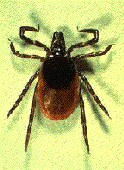Recurring fever is hallmark for this little-known infection, researchers say
TUESDAY, June 9, 2015 (HealthDay News) — The same ticks that spread Lyme disease may also carry a rarer bacteria, Borrelia miyamotoi, that’s causing serious illness in the northeastern United States, according to a new report published online June 9 in the Annals of Internal Medicine.
Philip Molloy, M.D., medical director of Imugen Inc., a Norwood, Mass.-based company that develops blood tests for tick-borne diseases, and colleagues reviewed 51 out of 97 Borrelia miyamotoi disease (BMD) infections identified from thousands of blood samples taken in 2013 and 2014.
The tick that spreads BMD is the tiny, hard-bodied deer tick (Ixodes scapularis). These ticks carry six germs that can infect humans, Peter Krause, M.D., a senior research scientist at the Yale School of Public Health in New Haven, Conn., and coauthor of an accompanying journal editorial, told HealthDay. A recurring fever is a hallmark of the infection. If treated early, the fever does not return. A rash is seen in fewer than 10 percent of patients, as opposed to 90 percent of people infected with Lyme disease, he said.
August appears to be the peak time for BMD, a month later than the peak time for Lyme disease. This difference is due to the life cycle of the tick, which spreads different diseases at different times, Krause explained. Many patients have probably been misdiagnosed and treated incorrectly. “Until recently, no one was even looking for BMD in this country,” Krause said. “We know now it’s in this country and it has probably been here for a long time.”
The study was funded by Imugen.
Full Text (subscription or payment may be required)
Editorial (subscription or payment may be required)
Copyright © 2015 HealthDay. All rights reserved.








